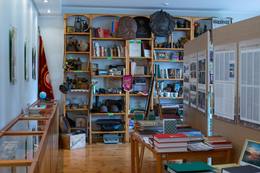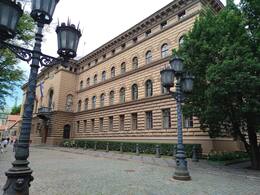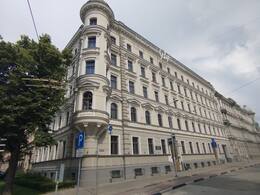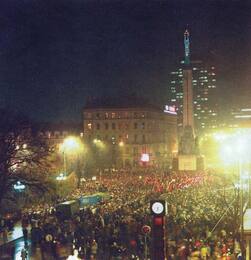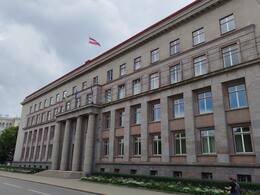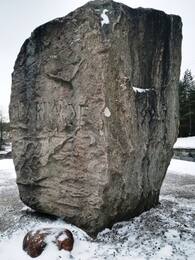Barikados
IV Sovietų okupacija, Atkurta Nepriklausomybė
1991 m. sausį Latvijos nepriklausomybės priešininkai bandė sustabdyti nepriklausomybės atkūrimo procesą ir nuversti teisėtą Latvijos Respublikos vyriausybę. Siekiant pasipriešinti tokiems agresyviems veiksmams, aplink daugelį strategiškai svarbių pastatų buvo pastatytos barikados, o daugybė gyventojų patruliavo prie jų. Dėl plataus visuomenės įsitraukimo nepriklausomybės priešininkų bandymas užgrobti valdžią žlugo. 1991 m. sausio mėn. barikados yra puikus tarptautinės svarbos nesmurtinio pasipriešinimo pavyzdys.
Pasinaudodama SSRS įgyvendintomis politinėmis reformomis devintojo dešimtmečio antroje pusėje, Baltijos šalių visuomenė aiškiai pareiškė norą atkurti Baltijos valstybių nepriklausomybę. 1988 m. Baltijos šalyse buvo įkurti liaudies judėjimai (Latvijoje – Latvijos liaudies frontas arba LTF), kurie netrukus paskelbė, kad jų pagrindinis tikslas – atkurti Baltijos valstybių nepriklausomybę. Latvijoje LTF laimėjo 1990 m. kovo–balandžio mėn. vykusius rinkimus, kurie leido jai priimti 1990 m. gegužės 4 d. Nepriklausomybės deklaraciją, pritarus daugiau nei dviem trečdaliams deputatų. Nepaisant pergalės rinkimuose ir deklaracijos priėmimo, SSRS centrinė valdžia nepripažino Nepriklausomybės deklaracijos, ir 1990 m. gegužės 14 d. SSRS prezidentas M. Gorbačiovas pasirašė dekretą dėl Baltijos valstybių nepriklausomybės deklaracijų neteisėtumo.
Nepaisant M. Gorbačiovo pažadų nenaudoti smurtinių metodų valdžiai pakeisti Baltijos šalyse, Lietuvoje ir Latvijoje, 1991 m. sausį įvyko SSRS armijos ir vidaus reikalų įstaigų išpuoliai prieš vietos valdžios institucijas ir strateginius objektus. Padėtis Latvijoje paaštrėjo sausio 14–20 d., kai periodiškai SSRS specialiųjų pajėgų kovotojai išpuoliavo prieš Latvijos valdžios institucijas. Per šiuos išpuolius žuvo tarnybines pareigas atliekantys darbuotojai ir civiliai gyventojai. Aktyvus visuomenės įsitraukimas, blokuojant prieigą prie valstybės valdymo institucijų ir strateginių objektų (barikadų), sužlugdė bandymą nuversti teisėtą valdžią Latvijos Respublikoje.
1991 m. sausį kovoje su agresoriais buvo sumaniai naudojami taikaus pasipriešinimo metodai. Vyriausybės ir Latvijos nacionalinio išsivadavimo fronto kvietimu aplink nacionalinės svarbos objektus buvo skubiai įrengtos barikados, kurias saugojo neginkluoti civiliai. Barikadų kūrime dalyvavo gyventojai iš visos Latvijos, kaimo regionų atstovai atvyko su sunkia žemės ūkio, miško kirtimo ir kt. technika. Buvo organizuojami budintys dalyviai ir, prireikus, užtikrinamas reguliarus dalyvių pakeitimas. Savanoriai pristatė maisto, buvo paruošti medicinos pagalbos punktai, kuriuose budėjo medikai. Barikadose tiesiogiai dalyvavo apie 40–50 tūkstančių žmonių, o keli šimtai tūkstančių gyventojų netiesiogiai dalyvavo įvairiuose mitinguose. Kiekviename objekte buvo statomos barikados, atsižvelgiant į realią situaciją. Statant barikadas aplink Ministrų Tarybos pastatą, buvo naudojami tiek sunkiasvoriai sunkvežimiai, pastatyti tankioje kolonoje, tiek mediena.
Nepaisant to, kad Persijos įlankos karas Artimuosiuose Rytuose prasidėjo barikadų metu, įvykiai Rygoje atkreipė dėmesį visame pasaulyje. Rusijos Aukščiausiosios Tarybos pirmininkas Borisas Jelcinas paragino kareivius ir karininkus nedalyvauti smurtiniuose veiksmuose prieš Baltijos respublikų gyventojus. Sausio 20 d. Maskvoje įvyko mitingas, kuriame apie 100 000 žmonių susirinko išreikšti savo paramą Baltijos šalims. SSRS pripažino Baltijos valstybių nepriklausomybę tik tada, kai ji jau buvo faktiškai žlugusi po 1991 m. rugpjūčio mėn. perversmo Maskvoje. 1991 m. barikados yra vienas iš Latvijos nepriklausomybės atkūrimo simbolių. Atkūrus nepriklausomybę, barikadoms atminti rengiami didelio masto minėjimo renginiai. Barikadų dalyviams įteikiami atminimo ženklai. Nuo 2001 m. Rygoje, Krāmu gatvėje 3, veikia 1991 m. barikadų muziejus.
Daugiau informacijos šaltinių
www.mk.gov.lv/simtgade/Kelyje į Latvijos valstybę
100 įvykių Latvijos istorijoje, žmonės ir procesai 1918–2018 m. Latvijos žiniasklaida
Susijusi laiko juosta
Susijusios vietos
Atminimo akmuo 1991 m. barikadoms atminti
Pirmąjį memorialą Latvijoje, skirtą 1991 m. barikadų laikotarpiui atminti, savo granito gaminių individualioje įmonėje pagamino Valmieros gyventojas Jānis Sprudzāns, o pamatus sukūrė SIA „Grods“. Memorialo idėjos autorius buvo Valmieros policijos majoras Aleksandras Melngāršas (1954–2014), kuris vadovavo Valmieros policijos pareigūnų grupei 1991 m. sausio įvykių Rygoje metu. Memorialinio ženklo eskizus ir dizainą sukūrė Dainis Saulītis. Jis buvo atidengtas 2002 m. sausio 24 d. Iš pradžių memorialinis ženklas buvo pastatytas Rygos ir Granto gatvių kampe privačioje žemėje, o vėliau, 2010 m., perkeltas į priešais esantį Valstybinės policijos Vidžemės regiono administracijos pastatą.
1991 m. barikadų muziejus
Muziejus yra Senojoje Rygoje, netoli Rygos katedros. Jis buvo įkurtas 2001 m., siekiant išsaugoti istorinius 1991 m. įvykių Latvijoje įrodymus. Taip pat galima virtualiai aplankyti muziejų. 1991 m. sausį Lietuvoje Sovietų armija apšaudė prie Vilnios televizijos bokšto susirinkusius žmones ir tankais įvažiavo į minią. Reaguodama į šiuos įvykius, Rygoje buvo surengta apie 500 000 žmonių demonstracija, kuria siekta parodyti paramą lietuviams ir Latvijos žmonių pasirengimą tęsti kovą už Latvijos nepriklausomybę. Siekdami užkirsti kelią panašiems įvykiams Latvijoje, gyventojai pradėjo statyti barikadas siaurose Senosios Rygos gatvėse, kad užkirstų kelią galimiems Sovietų armijos išpuoliams prieš barikadų gynėjus. Šios barikados taip pat buvo kuriamos įvairiuose strateginiuose objektuose ne tik Rygoje, bet ir visoje Latvijoje. Ginant barikadas dalyvavo apie 50 000 žmonių iš visos Latvijos. Barikados buvo populiarus judėjimas, padėjęs atgauti Latvijos nepriklausomybę. Tai puikus nesmurtinio pasipriešinimo pavyzdys viso pasaulio istorijoje.
Vaidavos parapijos kraštotyros nuolatinė ekspozicija
Įsikūręs Vaidavos kultūros ir amatų centre.
Eksponuojama paroda, skirta 1949 m. trėmimų atminimui, taip pat Vajdaviečių dalyvavimui Rygos barikadose 1991 m. sausį. Parodoje taip pat eksponuojami pasaulinių karų įrodymai (daugiausia spausdinta medžiaga).
Gamtos ir istorijos objektai, dvarai, švietimo istorija, kultūra, žymūs žmonės, kolūkio laikų medžiaga, namų apyvokos rakandai, banknotai, laikraščiai, žurnalai apie Vaidavos parapiją.
Domo aikštėje Senojoje Rygoje
Domo aikštės svarbą Atbudimo laikotarpiu daugiausia lėmė dvi aplinkybės – ji buvo įsikūrusi visai šalia Latvijos SSR Aukščiausiosios Tarybos pastato, taip pat tai, kad aikštėje yra Latvijos radijo pastatas. Domo aikštėje buvo rengiami įvairūs veiksmai, kurių metu Aukščiausiajai Tarybai buvo keliami reikalavimai, pavyzdžiui, 1989 m. liepos 26 d. Latvijos darbo federacija surengė mitingą, kuriame dalyvavo 60 000 žmonių, reikalaudama, kad Aukščiausioji Taryba priimtų Suvereniteto deklaraciją. Būtent šiame mitinge buvo iškeltas tuo metu populiarus šūkis „Kažkas praeityje, bet laisvoje Latvijoje“.
Kupolo aikštė buvo pagrindinė barikadų gynėjų susibūrimo vieta 1991 m. sausį, saugojusi Aukščiausiąją Tarybą ir Radijo rūmus. Barikadų gynėjai šildėsi prie laužų. Jie taip pat apsistojo Radijo rūmuose ir Kupolo bažnyčioje. Bažnyčioje buvo įrengta pirmosios pagalbos stotis, vyko pamaldos. Vakarais aikštėje improvizuotoje scenoje koncertavo populiarios roko grupės. Kiekvienais metais Kupolo aikštėje rengiami barikadų minėjimo renginiai.
Netoli Domo aikštės, Krāmu gatvėje 3, yra 1991 m. barikadų muziejus. 2018 m. sausio 13 d. Domo bažnyčioje buvo atidengtas menininkų Krišo ir Dzintaro Zilgalvjų vitražas „Su aistra už laisvą Latviją“ – dedikacija 1991 m. barikadoms ir Latvijos nepriklausomybei.
Parlamento rūmai (Saeima)
Buvusiuose Vidžemės riterių namuose nuo 1922 m. įsikūręs Latvijos parlamentas. Sovietų okupacijos metu čia buvo įsikūręs pseudoparlamentas – Latvijos SSR Aukščiausioji Taryba. 1990 m. kovo mėn. vykusiuose Aukščiausiosios Tarybos rinkimuose pagrindinis klausimas buvo Latvijos valstybinės nepriklausomybės atkūrimas. Tai buvo padaryta laikantis Latvijos liaudies fronto pozicijos, kuri teigė, kad realiau tai padaryti pasinaudojant esamomis SSRS valdžios struktūromis. Norint laimėti kvalifikuotą balsavimą Aukščiausiojoje Taryboje, reikėjo 134 balsų.
1990 m. gegužės 4 d. Latvijos TSR Aukščiausioji Taryba priėmė deklaraciją „Dėl Latvijos Respublikos nepriklausomybės atkūrimo“. Už jos priėmimą balsavo 138 deputatai, 1 susilaikė, tačiau 57 deputatai, pasisakę už Latvijos likti SSRS sudėtyje, balsavime nedalyvavo. Priėmus deklaraciją, Latvijos teritorijoje buvo atkurta 1922 m. Konstitucija, tačiau iki naujos Konstitucijos redakcijos priėmimo jos galiojimas buvo sustabdytas, išskyrus pirmuosius tris Konstitucijos straipsnius. Toks pereinamasis laikotarpis buvo nustatytas iki Latvijos Respublikos Saeimos sušaukimo. Gegužės 4 d. minima Latvijos Respublikos nepriklausomybės atkūrimo diena.
1990 m. gegužės 15 d. nepriklausomybės priešininkai, pasitelkę civiliais drabužiais apsirengusius karo kadetus, bandė užimti Aukščiausiąją Tarybą, tačiau spontaniškai susiorganizavę Politechnikos instituto ir Kūno kultūros instituto studentai atrėmė puolimą. Antrąjį bandymą pulti Aukščiausiąją Tarybą sustabdė milicija (OMON dalinys, kuris 1990 m. birželį atsisakė paklusti Latvijos Respublikos vyriausybei ir tapo pagrindine nepriklausomybės priešininkų smogiamąja jėga).
Aukščiausioji Taryba 1991 m. sausį buvo vienas svarbiausių barikadų apsaugos taškų. Jos prieigos buvo aptvertos gelžbetonio blokais, ir šios apsauginės konstrukcijos ten buvo iki nesėkmingo perversmo Maskvoje 1991 m. rugpjūčio 19–21 d. Sovietų Sąjungos desantininkams ir OMON kovotojams nepavyko užimti Aukščiausiosios Tarybos, o jos deputatai tęsė savo darbą. Rugpjūčio 21 d., 13 val., keturi OMON šarvuočiai įžengė į Domo aikštę ir liko ten iki 14 val. 10 min., bandydami įbauginti deputatus, kurie tuo metu (13 val.) priėmė Konstitucinį įstatymą dėl Latvijos Respublikos valstybinio statuso (už balsavo 111 deputatų, 13 – prieš). Tai panaikino 1990 m. gegužės 4 d. nustatytą pereinamąjį laikotarpį, skirtą de facto atkurti valstybės valdžią Latvijos Respublikoje, ir Latvija atgavo visišką nepriklausomybę. 2007 m. prie Saeimos rūmų Jėkabos gatvėje buvo atidaryta 1991 m. sausio barikadų atminimo vieta, o 2000 m., minint Latvijos Respublikos nepriklausomybės atkūrimo 30-ąsias metines, prie pagrindinio Saeimos įėjimo buvo įrengta atminimo lenta su užrašu: „Šiame pastate 1990 m. gegužės 4 d. Aukščiausiosios Tarybos deputatai priėmė deklaraciją dėl Latvijos Respublikos nepriklausomybės atkūrimo“.
Bastejkalns rajonas Rygoje
Bastėjokalnio apylinkėse yra keletas barikadų laikų memorialinių vietų. Aikštė, esanti Smilšu ir Torņa gatvių sankryžoje, priešais Parako bokštą, 2016 m. buvo pavadinta 1991 m. Barikadų aikšte. Čia dislokuota sunkioji technika saugojo Senąją Rygą nuo įsiveržimo į strategiškai svarbią vietą. Netoliese esančiame Latvijos karo muziejuje buvo įsikūręs pirmasis barikadų stulpas.
1991 m. sausio 20 d. Bastejkalns apylinkėse įvyko OMON išpuolis prieš Vidaus reikalų ministeriją, nusinešęs kelių žmonių gyvybes. Kanalo pakrantės žalumose, priešais Bastejkalnsą, tose vietose, kur aukos buvo mirtinai sužeistos, pastatyti memorialai – akmenys milicijos leitenantui Vladimirui Gamanovičiui, vidaus reikalų departamento inspektoriui Sergejui Kononenko, Rygos kino studijos direktoriui Andriui Slapiniui, moksleiviui Edijui Riekstiniui ir nušauto vaizdo operatoriui Gvido Zvaigznesui, žuvusiems vasario 5 d. Yra versija, kad šauliai buvo ne tik OMON nariai, bet ir kokia nors „trečioji jėga“ – arba iš specialiojo dalinio „Alfa“, arba SSRS valstybės saugumo komiteto darbuotojai iš Maskvos, kurie išprovokavo OMON išpuolį prieš Vidaus reikalų ministeriją.
Kanalo pakrantės soduose taip pat pastatytas atminimo akmuo 1991 m. rugpjūčio 19 d. aukai Raimondui Salminiui, kurį riaušių policija nušovė netoli Rygos miesto policijos nuovados pastato Aspazijas bulvaro ir 13-osios gatvės sankryžoje. 2014 m. prie buvusio Vidaus reikalų ministerijos pastato Rainio bulvaro ir Reimersos gatvės kampe buvo įrengta atminimo lenta, skirta 1991 m. sausio 20 d. išpuolio prieš Vidaus reikalų ministeriją aukoms atminti.
Laisvės paminklas Rygoje
Laisvės paminklas buvo vienas iš centrinių simbolinių Atgimimo įvykių taškų. 1987 m. birželio 14 d. žmogaus teisių grupė „Helsinki-86“ surengė nesankcionuotą viešą gėlių padėjimo ceremoniją prie Laisvės paminklo. Po dviejų mėnesių, rugpjūčio 23 d., „Helsinki-86“ paragino surengti mitingą prie Laisvės paminklo, minint 48-ąsias Hitlerio ir Stalino pakto, pasirašyto 1939 m. rugpjūčio 23 d., metines. Šio mitingo metu sovietų policija sumušė ir suėmė demonstrantus. Vėlesniais metais gėlių padėjimo ceremonijos prie Laisvės paminklo tapo visų didesnių demonstracijų ir kitų masinių renginių dalimi.
Įsikūręs Rygos centre, Laisvės aikštėje.
Laisvės paminklas yra vienas iškiliausių Latvijos istorijos, architektūros ir meno paminklų. Pastatytas pagal Kārlio Zālės projektą visuomenės aukomis. Jis buvo atidengtas 1935 m. kaip Latvijos žmonių laisvės ir meilės tėvynei simbolis. Kartu su Rygos brolių kapinių ansambliu jis yra vienas vertingiausių monumentaliosios architektūros ir skulptūros pavyzdžių.
Laisvės paminklas išreiškia Latvijos kultūros etines ir estetines vertybes. Simboliai atspindi filosofinę laisvės esmę ir Latvijos tautos istorines idėjas apie kovos už nepriklausomybę etapus. Jie nurodo į fizinės ir dvasinės stiprybės įsikūnijimą. Herojiška kalba pasakoja apie Latvijos žmones kaip savarankiškus, aktyvius istorijos kūrėjus ir savo likimo lėmėjus.
Jo vietoje iš pradžių stovėjo paminklas Rusijos carui Petrui I. Pirmojo pasaulinio karo metu jis buvo išardytas ir laivu nugabentas į Petrogradą. Laivą torpedavo vokiečių povandeninis laivas, ir jis nuskendo prie Estijos Vormsi salos. Sovietų okupacinis režimas kelis kartus planavo nugriauti Laisvės paminklą, tačiau to neįvyko.
Šiandien galite pamatyti vieną iš Latvijos simbolių ir stebėti kariuomenės garbės sargybos tradicijas.
Ant kanalo kranto, šalia Laisvės paminklo, sukurtas taktilinis Laisvės paminklas. Šią ypatingą bronzinę miniatiūrą 1:50 masteliu sukūrė skulptorius Ivaras Miķelsonsas.
Ministrų kabineto pastatas
1991 m. sausį vienas iš Latvijos nepriklausomybės priešininkų tikslų buvo neutralizuoti Ivaro Godmanio vadovaujamą Latvijos Respublikos vyriausybę, kuri buvo suformuota po Nepriklausomybės deklaracijos priėmimo 1990 m. gegužės 4 d. 1991 m. sausio 9 d. promaskvietiškoms jėgoms pavyko pasiekti Kazimiros Prunskienės vyriausybės atsistatydinimą Lietuvoje, mobilizuojant savo šalininkus protestams prieš mažmeninių kainų didinimą. Sausio 10 d. tuo pačiu pretekstu prie Ministrų Tarybos įvyko Interfronto organizuotas mitingas. Jame apie 10 000 dalyvių reikalavo I. Godmanio vyriausybės atsistatydinimo ir bandė įsilaužti į pastatą. Milicijai pavyko užkirsti kelią tokiems bandymams. Vyriausybė ir Aukščiausioji Taryba demonstravo vieningą poziciją, ir vyriausybė neatsistatydino.
Po tragiškų sausio 13-osios įvykių Vilnyje, Ministrų Tarybos pastatas buvo vienas pirmųjų objektų, aplink kurį buvo pastatytos barikados – gelžbetonio blokai, rąstai, smėlio maišai, sunkvežimiai ir traktoriai. Po 1991 m. perversmo pralaimėjimo, rugpjūčio 25 d. rytą, priešais Latvijos SSR Ministrų Tarybą esantis Lenino paminklas buvo demontuotas.
Atminimo vieta „Barikada“
Atminimo vieta „Barikada“ buvo įkurta Ulbrokoje, Rygos–Ērglių plento pakraštyje, netoli tilto per Piķurgos upę, kur 1991 m. sausį buvo du užtvaros postai. Vienas saugojo Rygos sieną, o kitas – Latvijos radijo bokštą Ulbrokoje. Sausio įvykių metu radijas buvo pagrindinis būdas gauti informaciją, todėl buvo svarbu neleisti nutrūkti radijo ryšiui. 125 metrų aukščio radijo bokštą, kuris buvo naudojamas Latvijos radijo programoms transliuoti vidutinių bangų diapazone, saugojo tiek vietos Ulbrokos gyventojai, tiek kaimynai iš Garkalnės, Adažių, Tīnūžių ir Ropažių.
Tekstas „Ulbroka.1991.I“ iškaltas dviejose vertikaliai pastatyto akmeninio bloko „Barikada“, kuris buvo atidengtas 1991 m. lapkričio 11 d. ir kurį sukūrė skulptorius Uldis Stergis, pusėse. Kiekvienais metais sausio 20 d. šioje vietoje rengiami 1991 m. sausio barikadoms skirti minėjimai. 2003 m. čia 33 Stopinių valsčiaus gyventojams buvo įteiktas vyriausybės apdovanojimas – Barikadų dalyvio atminimo medalis. 2024 m. Ulbrokos biblioteka sukūrė virtualią parodą „Barikados Ulbrokoje. 1991 m. sausis“.
Susijusi istorija
Vaidaviečiai ant barikadų
2020 m., artėjant 1991 m. barikadų 30-mečiui, Vismants Priedīte pasakoja apie vietos gyventojų dalyvavimą šiuose istoriniuose įvykiuose.
Kocēniečio Tālavo Megnio prisiminimai apie įvykius 1991 m. barikadų Rygoje
Kocēniečio Tālavo Megnio prisiminimai apie įvykius 1991-ųjų barikadų Rygoje.
„Sausio 13 d. apie 40 Kocėnų gyventojų organizuotai išvyko iš kolūkio į demonstraciją Rygoje autobusu „Laz“, kurį vairavo Vitalijus Spruktas, ir mikroautobusu „Latvija“, kurį vairavo Janis Grava.
Po demonstracijos, kai susitikome prie autobusų, kelis kartus per radiją girdėjome Latvijos liaudies fronto raginimą tiems, kurie gali, likti Rygoje ir ginti strategiškai svarbius objektus, kad būtų sunkiau juos užgrobti, panašiai kaip nutiko prie Vilnios televizijos. Šiuos kadrus matėme, kuriuos Podnieks nufilmavo prieš išvykdamas į Rygą.
Nuo Rėzeknės iki 1991 m. barikadų
Pasakotojai aprašo barikadų laikotarpio nuotaikas ir asmeninius išgyvenimus. Prisiminimai gerai iliustruoja, kaip informacija pasiekė Latvijos gyventojus visoje jos teritorijoje.




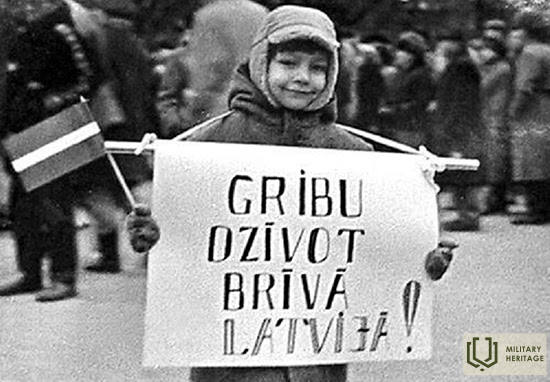

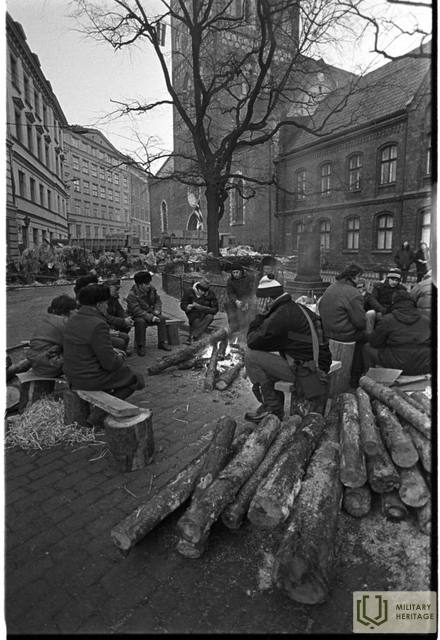
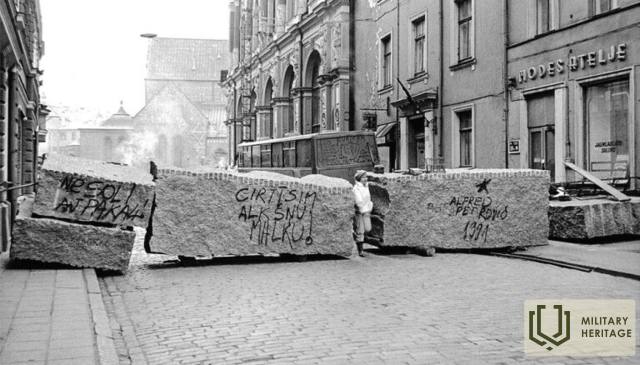
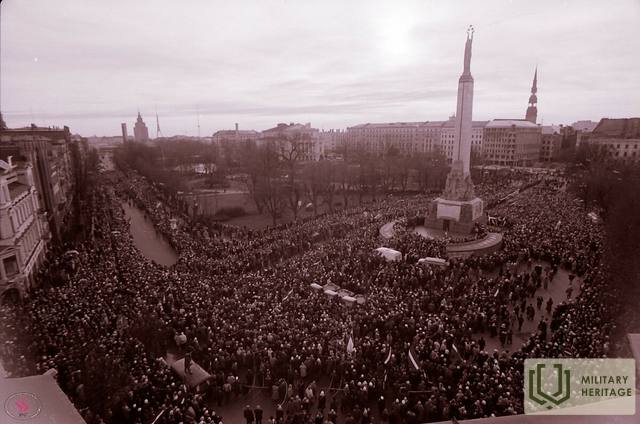


![Atminimo akmuo 1991 m. barikadoms Rygos gatvėje Valmieroje atminti. Šaltinis: „Valmiera“ [iliustruotas leidimas], išleido leidykla „Jumava“, 2008. - p. 87. Autorius: Nils Smelteris.](/g/Poi/00540/Dzelzcela-tilts-Valmiera_1922g2.jpg?size=260)

